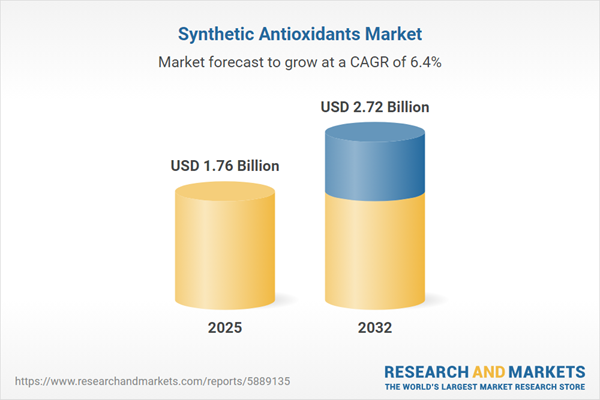Speak directly to the analyst to clarify any post sales queries you may have.
The synthetic antioxidants market is undergoing significant change as regulatory adjustments, supply chain complexity, and the need for operational precision reshape global strategies. Senior executives require clear analysis to navigate compliance challenges, sustain resilience, and drive forward-looking decisions in a rapidly evolving business landscape.
Market Snapshot: Synthetic Antioxidants Market Growth
The synthetic antioxidants market is projected to grow from USD 1.66 billion in 2024 to USD 1.76 billion by 2025, attaining USD 2.72 billion in 2032. A compound annual growth rate (CAGR) of 6.36% reflects ongoing demand for solutions that extend product shelf life and safeguard quality within critical industries. Sectors such as food and beverage, polymers, lubricants, and cosmetics continue to refine operational models to meet emerging regulatory requirements. Executives must focus on fostering innovation and managing risk, while addressing shifting compliance benchmarks and rising competition. Adoption of agile business practices is central to supporting industry resilience and responding effectively to evolving market demands.
Scope & Segmentation: Synthetic Antioxidants Industry Analysis
- Application Areas: Animal feed producers use synthetic antioxidants to maintain nutritional value. Cosmetics and personal care leaders focus on both safety and product identity. Food and beverage manufacturers protect various product categories, prioritizing stability and longevity. Lubricant and fuel suppliers rely on these ingredients for machinery reliability, while polymer producers serve automotive, construction, and packaging markets with enhanced durability and adherence to compliance standards.
- Types: Key compounds such as BHA, BHT, Propyl Gallate, and TBHQ cater to targeted industry needs, aligning with diverse requirements under international regulatory guidelines.
- Grades: Available in cosmetic, food, industrial, and pharmaceutical grades, synthetic antioxidants support stringent compliance and quality, aligning with sector-specific regulations.
- Forms: The market supports both liquid and powdered forms, allowing manufacturers flexibility in production and simplified logistics throughout the supply chain.
- Regions Covered: Analysis spans the Americas, EMEA, and Asia-Pacific, focusing on major economies including the United States, Germany, China, and India. Each region demonstrates distinct supplier networks, innovation priorities, and compliance structures, prompting tailored sourcing and adaptation strategies.
- Companies Profiled: Featured organizations include BASF SE, Eastman Chemical Company, Lanxess AG, Songwon Industrial Co., Ltd., Schill+Seilacher Strukturchemie GmbH, Adeka Corporation, R.T. Vanderbilt Holding Company, SI Group, Nouryon, and Mitsubishi Chemical Holdings. These firms lead in technical expertise, regulatory compliance, and strategic industry collaboration.
Synthetic Antioxidants Market: Key Takeaways for Decision-Makers
- Pursuing new antioxidant technologies and targeted quality initiatives enables organizations to uphold product reliability and minimize interruptions in operations.
- Enhancing operational agility and refining internal workflows supports compliance with emerging regulations and facilitates measurable progress toward sustainability outcomes.
- Deploying digital analytics platforms enhances market and regulatory tracking, allowing companies to adapt quickly to changes in customer behavior or compliance directives.
- Broadening supplier networks and advancing vertical integration bolster supply chain resilience and enable continued differentiation within competitive markets.
- Strengthening innovation and engagement throughout the value chain, at both local and international levels, mitigates sourcing risks and ensures ongoing procurement stability.
- Continuously refining offerings to address sector-specific requirements positions firms to respond to market fluctuations and evolving industry challenges with confidence.
Tariff Impact on Industry Supply Chains
Expected changes to U.S. tariffs in 2025 are projected to elevate procurement costs for synthetic antioxidants and certain raw materials. Industry leaders are responding by deepening domestic sourcing, investing in local production, and diversifying supplier portfolios. These strategies limit vulnerability to trade disruptions and enhance supply reliability for high-priority applications.
Methodology & Data Sources
This research synthesizes direct feedback from manufacturers, proprietary analytics, and recent regulatory intelligence. Verification is ensured through examination of technical documentation, patent reviews, and robust internal assessment frameworks crafted to support executive-level decisions.
Why This Report Matters
- Enables senior leadership to anticipate market shifts and sharpen strategic planning, utilizing comprehensive synthetic antioxidants market analysis.
- Delivers actionable scenarios for planning, risk management, and investment designed to strengthen organizational resilience and fiduciary agility.
- Equips leaders with refined practices for collaboration with suppliers and stakeholders, supporting a measured response to competitive and regulatory demands.
Conclusion
Effective leadership, informed analysis, and a coordinated approach to stakeholder relationships are essential for navigating change in the synthetic antioxidants market. This report delivers the strategic clarity required to address regulatory developments and achieve reliable business outcomes.
Additional Product Information:
- Purchase of this report includes 1 year online access with quarterly updates.
- This report can be updated on request. Please contact our Customer Experience team using the Ask a Question widget on our website.
Table of Contents
3. Executive Summary
4. Market Overview
7. Cumulative Impact of Artificial Intelligence 2025
Companies Mentioned
The companies profiled in this Synthetic Antioxidants market report include:- BASF SE
- Eastman Chemical Company
- Lanxess AG
- Songwon Industrial Co., Ltd.
- Schill+Seilacher Strukturchemie GmbH
- Adeka Corporation
- R.T. Vanderbilt Holding Company, Inc.
- SI Group, Inc.
- Nouryon
- Mitsubishi Chemical Holdings Corporation
Table Information
| Report Attribute | Details |
|---|---|
| No. of Pages | 192 |
| Published | November 2025 |
| Forecast Period | 2025 - 2032 |
| Estimated Market Value ( USD | $ 1.76 Billion |
| Forecasted Market Value ( USD | $ 2.72 Billion |
| Compound Annual Growth Rate | 6.3% |
| Regions Covered | Global |
| No. of Companies Mentioned | 11 |









